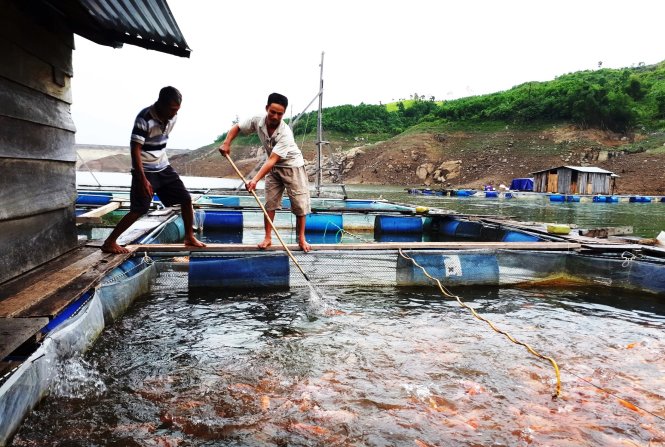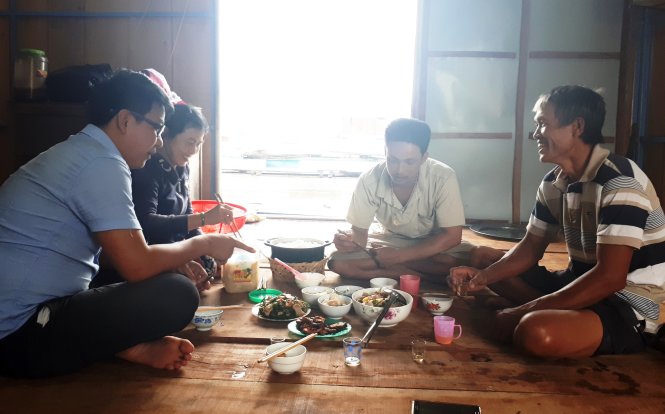Fish farmers’ floating life on
hydropower lake in central Vietnam
The young kids can easily fall into the river

Farmers tend to their fish grown on
the Song Tranh 2 Hydropower Reservoir in Bac Tra My District, located in the
central province of Quang Nam. Photo: Tuoi Tre
Over a dozen of households have
settled down with their fish cages at a hydroelectricity reservoir in central
Vietnam for years despite risks of drowning among their children and ravages
by typhoons.
The Song Tranh (Tranh River) 2
Hydropower Reservoir, located in Bac Tra My District, Quang Nam Province, is
dotted with 14 wooden houses surrounded by scores of fish cages.
The entire families initially put
down roots on the lake surface to get out of poverty.
From above, the encircling huts,
each with a fluttering national flag on the roof, cast shadow on the clear
lake surface.
Nguyen Ngoc Canh, 50, is believed to
be the earliest settler in the neighborhood.
He took his whole family from the
north-central province of Thanh Hoa to Bac Tra My District 23 years ago.
Canh shared his family, who had
previously eked out a meager living as a rice farmer, was one of the pioneers
to raise fish and live on the reservoir after the district administration
adopted a policy to encourage the practice five years ago.
“At first I came here alone, while
my wife and kids lived in our old house on land. Later on, I took them along
so that we could be together,” he added.
Canh’s relatively sturdy wooden hut
on the lake is fully equipped with furniture, television and other items.
The middle-aged man revealed the
district assisted him in obtaining a bank loan of over VND100 million (US$
4,322) to embark on the erection of his house and cages.
Canh initially invested in four
cages in which he kept dieu hong (Oreochromis), catfish and ro
phi (Tilapia).
He then switched to
higher-efficiency breeds such as ca chinh (eel fish) and frogs, and
increased the number of his cages to 20.
His family earn more than VND100
million each year and can afford their three children a proper education.
“My children and I were scared of
living afloat at first, but gradually got used to it. Now we don’t want to
live on land,” Nguyen Thi Xoan, Canh’s wife, said.
The fish farm run by Canh’s
fellowman and neighbor, 45-year-old Tran Van Mao, also flourishes.
Fish typically thrive in the middle
of the lake where the water is pure, he explained.
Mao has his hands full tending to
the enclosures every day, while his wife runs a store at the market that
sells fish to clients from across the district.
Their earnings from the cages
totaled more than VND200 million ($8,644) in 2016.
Mao had paid off his bank loan and
splashed out more money on expanding his business.
Likewise, Huynh Viet Dung, 38, the
youngest in the fish farming village, sold his house on land and took his
wife and children to the lake three years ago.
Most of the residents hailed from
central provinces, while the rest were members of Ca Dong ethnic minority
groups, native to the district and some neighboring localities.
Adversities, risks
All the daily activities and
traveling at the fish caging village take place by boat.
They take their children to school
on sampans every day.
Back from school, the kids stand
onshore, waiting for their parents to ride sampans to carry them home.
Better-off families use electricity
from generators, while children from needy households do their homework in
the dim kerosene light in the evening.
Their worst fear is that their
unattended children might fall into the water and drown.
“There were several times when the
minors tripped over and tumbled into the water. Luckily adults saved them
just in time,” Dung disclosed.
The villagers also dread the rainy,
storm-packed seasons, when the currents rage and the water levels rise by
dozens of meters, sending the huts to elevate as well.
They stayed awake all night long on
nights that saw gusts and torrential rains coupled with cyclones to keep a
watch on their fish enclosures to prevent huge waves from tearing the nets
and freeing the fish.
Canh revealed several suffered hefty
losses during last year’s rainy season as fish got out of the cages ripped
apart by cyclones.
“Houses shake violently during the
cyclones on the lakes, which can be really ferocious,” he said.
“Many got too scared to sleep at
night if their raft and house give way unless they put their life vests on,”
he added.
The area is also prone to
earthquakes, with the strongest quake that has ever struck Bac Tra My since
1957 happening in November 2012, measuring 4.7 on the Richter scale.
The quake, which lasted for several
seconds, got them to rush out of their houses in panic after they heard loud
blasts and felt the ground shaking, walls cracking, and household items
falling.
“But we are used to these inclement
weather conditions,” he said smilingly.
The occupants from the close-knit
neighborhood said the village comes alive during the days when they harvest
and sell their fish to traders.
After the sale, they prepare and
offer a sumptuous meal to water deities in the hope of auspicious weather and
hold a cozy get-together.
Their greatest concern is now their
output, with traders imposing low prices or refusing to buy the fish due to
rough terrain and limited transport.
They would suffer heavy losses due
to additional costs, particularly feed for the aquatic animals if no traders
come to buy them.
According to Phan Thanh Phuong,
deputy head of the Bac Tra My District Office of Agriculture and Rural
Development, district leaders observed successful models of raising fish on
the hydropower reservoir from other localities in early 2012, before piloting
them on one household on the Song Tranh 2 reservoir.
The model was later expanded, with
district authorities offering these needy households no-interest loans of up
to VND120 million ($5,187) each, fish for breeding purposes and technical
assistance.
The lake is currently home to 14
farming households with 180 cages which produce approximately 1,200 metric
tons of mature fish annually.
“Thanks to their diligence and
efforts in seeking economically-effective breeds, several have paid off their
loans, expanded their business and made a decent living,” Phuong said.
Tuoitrenews
|
Thứ Ba, 14 tháng 11, 2017
Đăng ký:
Đăng Nhận xét (Atom)

Không có nhận xét nào:
Đăng nhận xét